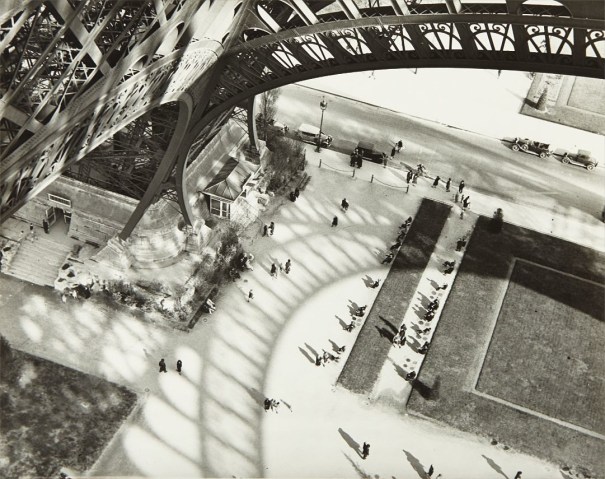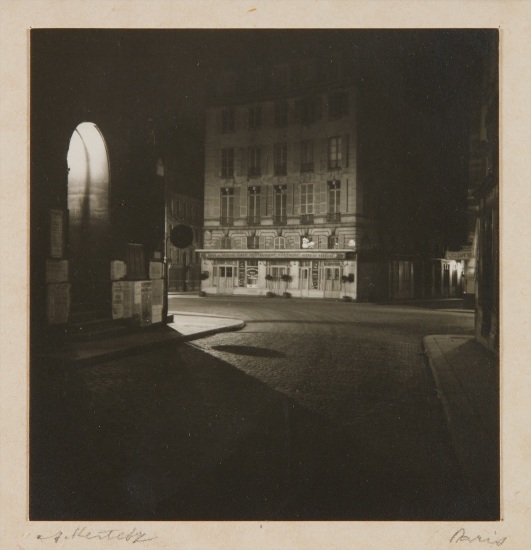THE FACE OF MODERNISM: A PRIVATE WEST COAST COLLECTION André Kertész Fishermen Behind Notre Dame, Paris 1925 Gelatin silver print, printed 1930s. 9 1/8 x 5 3/4 in. (23.2 x 14.6 cm) Signed twice, dated in pencil, '307 E. 44th St., New York, Murray Hill' copyright credit stamp (address crossed out in pencil) and printer's notations on the verso.
Provenance Allan Frumkin Gallery, Chicago Private Collection, New York Literature Borhan, André Kertész His Life and Work, p. 98 Éditions D’Histoire et D’Art, Paris Vu Par André Kertész frontispiece Kertész, J’Aime Paris: Photographs Since the Twenties, p. 14 National Gallery of Art, André Kertész fig. 23 Quasha, Paris in the Twenties and Thirties, p. 2 Thames & Hudson, André Kertész Of Paris and New York, p. 130 Catalogue Essay The year 1925 marked a benchmark in Modernist photography, when André Kertész a self-taught Hungarian photographer, moved to Paris. As the European center for avant-garde thinkers and artists in the 1920s, Paris was a refuge from Kertész’s conservative home country, where the salon-favored mode of Pictorialism still dominated photography. Soon after his arrival, Kertész found himself in a culture that endorsed subverting the antiquated principles of photography, and began rotating his camera lens on literal and metaphoric axes to remarkable results. Fishermen Behind Notre Dame, taken the year Kertész moved to Paris, incorporates the lauded French 12th-century Gothic cathedral into the composition. As a distinguished landmark in Paris, it had been photographed since the 19th-century by such masters as Gustave Le Gray Henri Jean-Louis Le Secq and Alfred-Nicolas Normand. Their images were consistently reverential of the overwhelming grandeur and architectural details that typify the cathedral. Conversely, Kertész turned his camera to a back corner that lends few if any clues to the location. It is likely that his outsider status, both as an émigré and a self-taught photographer, propelled Kertész to photograph the cathedral from an unusual angle, capturing the light and atmosphere of Paris without photographing the façade. Read More
THE FACE OF MODERNISM: A PRIVATE WEST COAST COLLECTION André Kertész Fishermen Behind Notre Dame, Paris 1925 Gelatin silver print, printed 1930s. 9 1/8 x 5 3/4 in. (23.2 x 14.6 cm) Signed twice, dated in pencil, '307 E. 44th St., New York, Murray Hill' copyright credit stamp (address crossed out in pencil) and printer's notations on the verso.
Provenance Allan Frumkin Gallery, Chicago Private Collection, New York Literature Borhan, André Kertész His Life and Work, p. 98 Éditions D’Histoire et D’Art, Paris Vu Par André Kertész frontispiece Kertész, J’Aime Paris: Photographs Since the Twenties, p. 14 National Gallery of Art, André Kertész fig. 23 Quasha, Paris in the Twenties and Thirties, p. 2 Thames & Hudson, André Kertész Of Paris and New York, p. 130 Catalogue Essay The year 1925 marked a benchmark in Modernist photography, when André Kertész a self-taught Hungarian photographer, moved to Paris. As the European center for avant-garde thinkers and artists in the 1920s, Paris was a refuge from Kertész’s conservative home country, where the salon-favored mode of Pictorialism still dominated photography. Soon after his arrival, Kertész found himself in a culture that endorsed subverting the antiquated principles of photography, and began rotating his camera lens on literal and metaphoric axes to remarkable results. Fishermen Behind Notre Dame, taken the year Kertész moved to Paris, incorporates the lauded French 12th-century Gothic cathedral into the composition. As a distinguished landmark in Paris, it had been photographed since the 19th-century by such masters as Gustave Le Gray Henri Jean-Louis Le Secq and Alfred-Nicolas Normand. Their images were consistently reverential of the overwhelming grandeur and architectural details that typify the cathedral. Conversely, Kertész turned his camera to a back corner that lends few if any clues to the location. It is likely that his outsider status, both as an émigré and a self-taught photographer, propelled Kertész to photograph the cathedral from an unusual angle, capturing the light and atmosphere of Paris without photographing the façade. Read More




.jpg)

Testen Sie LotSearch und seine Premium-Features 7 Tage - ohne Kosten!
Lassen Sie sich automatisch über neue Objekte in kommenden Auktionen benachrichtigen.
Suchauftrag anlegen